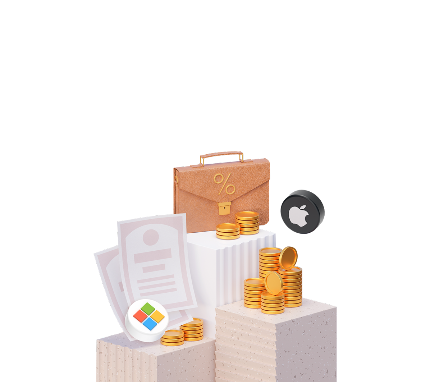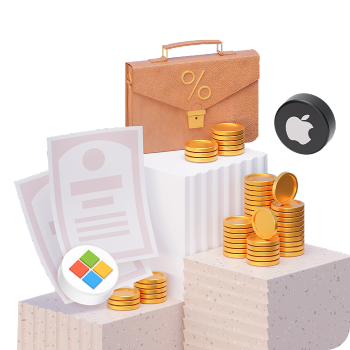What Is Quantitative Easing and How Does It Influence Currency Rates?

6 minutes for reading
Quantitative Easing is an instrument used by Central banks to add money directly to the country’s economy. QE does not imply printing a lot of physically existing money, rather, this is a process that creates non-cash funds.
As the next step, the Central bank buys bonds in the private sector. This is also called “buying the government debt”. As a result, the profitability of these bonds decreases, while the overall money supply in the economy grows, in contrast.
The logic is simple: when private companies have more money, they can produce more goods and services. The more services and goods there are in the market, the more money consumers will spend on them, pouring the money into the economy. This is How QE helps the economy develop.
Mind that some analysts under QE mean simple asset buying by the Central bank. Remember here that the goal of QE is to increase spending and investments in the economy by creating non-cash funds.
Let us figure out why Central banks use QE at all, how it works, and how an investor can profit from it.
What is QE necessary for?
Clearly, Central banks do not use this measure all the time. QE is a reply to the economic situation in the country that forms under the influence of global trouble; it can also be solving particular problems. For example, it might be aimed at holding inflation and the growth of prices for goods and servicing at a low and, most importantly, stable level.
Another instrument for reaching such a goal is decreasing the key interest rate in the country’s economy. It also supports the development of the economy in times of global crises or recessions.
Low interest rates let private companies and enterprises get cheap loans, inspiring them to spend the loaned money and invest in the development of their business. For physical persons, this works the same way – in, say, mortgages.
However, there is a certain limit to interest rates, so that they cannot be lower than this level. Hence, Central banks use QE when lowering the rate becomes unreasonable and even harmful.
How does QE work?
The rates of state bonds directly influence other interest rates in the country’s economy. If the CB buys a lot of bonds, the interest rates (profitability) of the latter fall, which, in turn, brings down loan rates. We can conclude that QE makes loans cheaper for the private sector, stimulating their spending.
However, this is not all the potential of this measure: QE can also support the economy by the potential growth of prices for various financial assets.
For example, the Central bank buys bonds for 1 million USD from the pension fund, so the fund gets real money instead of bonds. The fund will hardly just keep in on its accounts; instead, it can invest in various financial instruments such as stocks of large companies that can yield much larger profits. Thanks to this, stock markets also grow: when more investors want to buy certain stocks, the price for the latter ones also grows actively.
Next, we have a more direct correlation: when stock prices grow, the capital of their investors also increases; they now have more money to spend, and their spending stimulates economic activity in the country.
Summing up: buying bonds decreases loan rates and supports the stock market. People and companies have more money to spend and thus spend more, supporting the economy.
However, if the private sector just saves the money it has got from the CB, QE will simply not work.
How does QE influence the currency of the country?
At first glance, QE looks like a perfect way to escape an economic crisis threatening the country. However, it entails several potential risks, one being the weakening of the national currency.
An increase in money supply can lead to the devaluation of the national currency against other world currencies – especially those of such countries where the CB does not carry out QE. Things are again logical: money supply increases noticeably, hence, its price in the world market drops. As a rule, the devaluation happens at the start of QE, while closer to the end of the program, the currency can grow significantly.
How did the QE carried out by the Fed influence the USD?
Let us have a look at how QE influences the price of financial assets on the example of QE by the US Fed.
These years, there have been 3 rounds of QE:
- QE1 started in December 2008 and ended in March 2010;
- QE2 started in November 2010 and ended in June 2011;
- QE3 started in September 2012 and ended in October 2014.
Experts say there was a fourth round that began in September 2019 but the Fed has never announced it officially. Moreover, the head of the Fed asked against calling those measures QE because they were aimed at normalizing the work of financial markets instead of decreasing interest rates.
Now to assets. With the stock market, things are quite clear: investors buy stocks actively, and the stock market is growing. Stock indices follow suit and react positively at QE – just look at the growth of the S&P 500 in November 2008 during the Fed’s QE. Subsequent programs also supported stock indices.
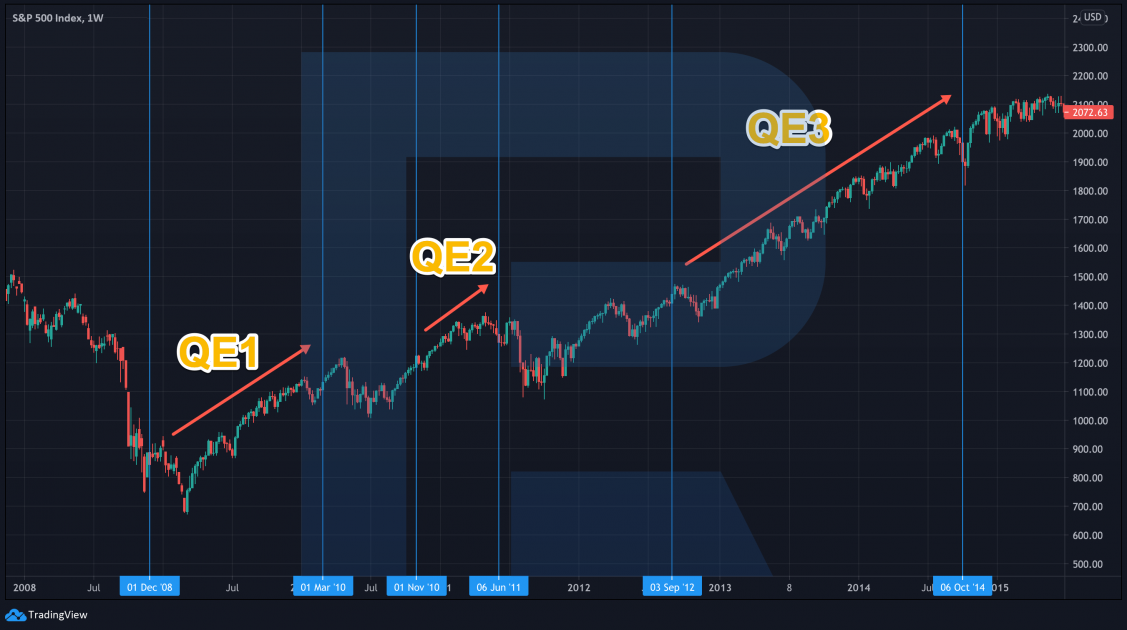
However, if we look at the EUR/USD chart, we can see the US currency fall when the program was announced and being carried out. Closer to the end of QE, the dollar started to grow.
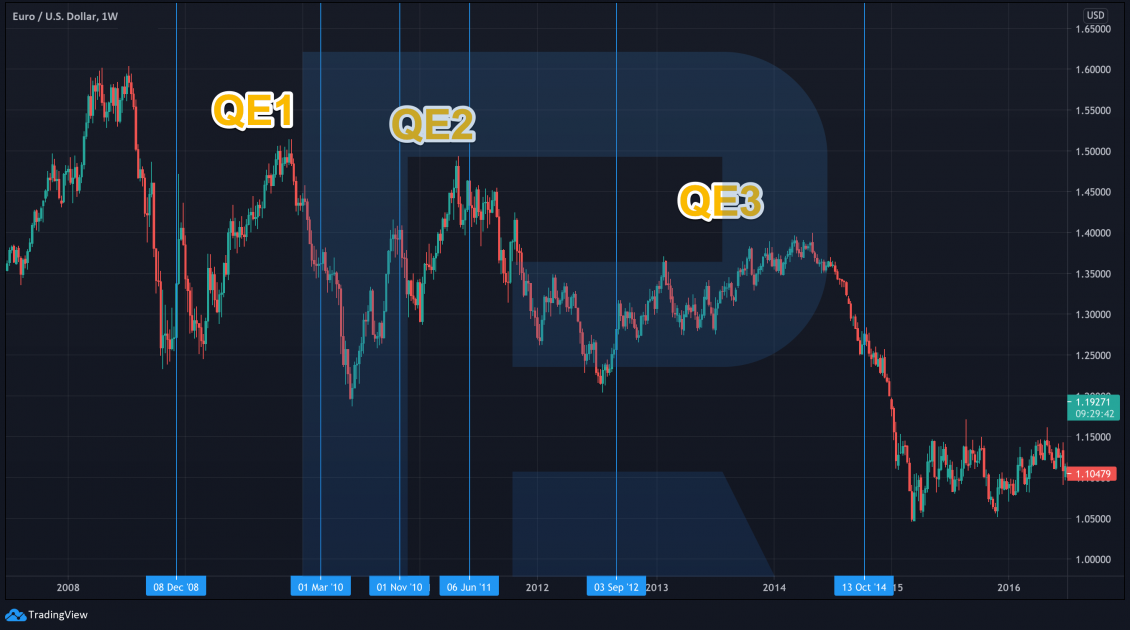
If we suppose that the fourth tour rejected by the Fed started in October 2019, the dollar supported it by a decline against the European currency – from 1.09 to 1.23.
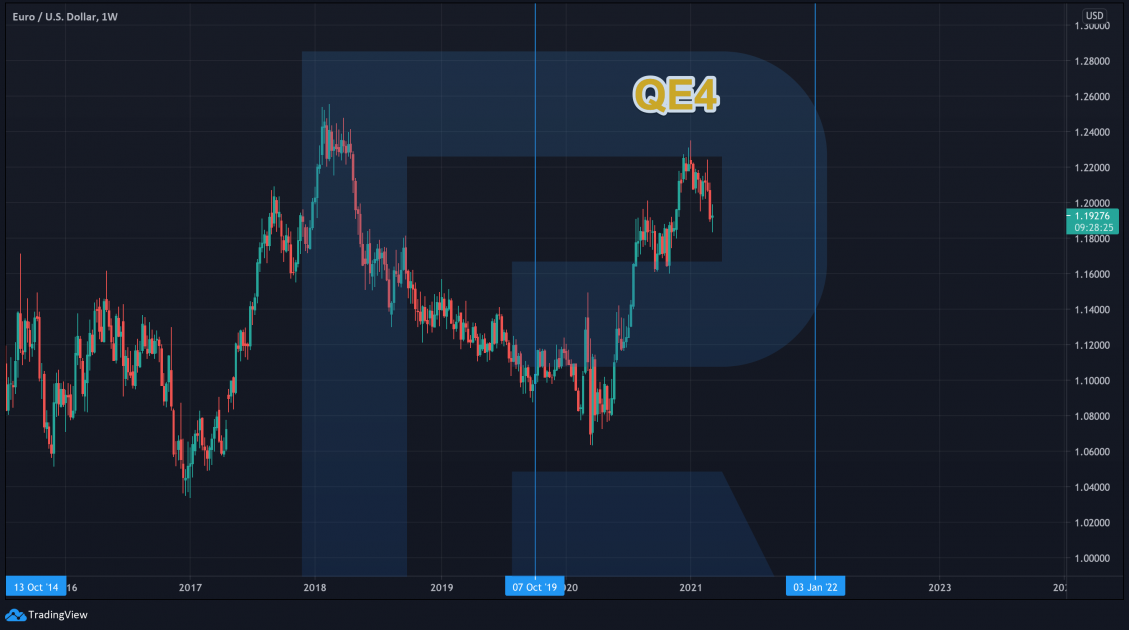
Some say that the program must end in 2022; hence, the dollar should start growing actively around these dates as it used to do at the end of previous programs. Closer to the end of the current 2021, we might witness another falling of EUR/USD to 1.05 and lower.
Closing thoughts
Quantitative Easing is an instrument of Central banks by which they add more money to the country’s economy to stimulate consumption and production in the country. The instrument is used as the last resort when a decrease in the interest rate can only harm the economy.
Adding more money to the economy, as a rule, makes the exchange rate of the national currency fall against world currencies. This can be seen in the example of the USD and the Fed’s policy: the launch of QE made the dollar drop, while at its end, the dollar grew aggressively. This might serve as a signal to open positions.
Market analysis can be different: from drawing simple levels and lines on the chart (tech analysis) to more complicated types where we track the policy of Central banks and economic development (fundamental analysis). In the second case, we see a certain pattern based on our investigations and find out how they influence currencies.
Anyway, traders must not forget about the principles of money- and risk management. They are necessary for any type of analysis you choose.
